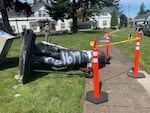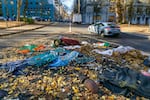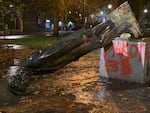
A statue of George Washington was pulled down from the lawn outside the German American Society in Northeast Portland on June 18, 2020.
Rebecca Ellis/OPB
In the midst of Portland’s 2020 racial justice protests, demonstrators knocked down and damaged five monuments across the city. The action inspired Portland City Council to rethink the way the city chooses who gets to be memorialized in public spaces, a decision cheered by Portland artists, historians and activists. The intent was to both draft a new city policy and to have a public conversation about why some historic monuments sparked offense.
But the plan began to unravel as a city commissioner entering an election year pushed to fast-track the process — going against experts’ advice and potentially costing the city tens of thousands of dollars along the way.
“Everything was in place for this to be a successful project,” said Amara Pérez, a social justice educator and researcher hired by the city to help oversee the project.
Pérez is one of two experts hired to carry out the monuments project who have quit in recent months over changes led by Commissioner Dan Ryan’s office.
“I think that the public needs to know why a city commissioner would undermine an equity-driven process,” Pérez said. “Unfortunately, the city is where power gets held and where inequity gets reproduced.”
To some, the five bronze and stone statues torn down in 2020 represented the city and country’s racist history: from slave-owning U.S. presidents to a former Oregonian publisher who violated Indigenous treaty rights. Those critics wanted the monuments gone. To others, the monuments’ demise was nothing more than an act of vandalism, and they demanded the statues be immediately restored and returned.

Protesters doused a sculpture honoring Oregon settlers in red paint and messages against colonialism during protests in 2020. The monument, called "The Promised Land," was installed in Portland's Chapman Square in 1993. It's currently being held in storage.
Courtney Sherwood / OPB
Commissioner Ryan insists on monuments’ return no later than February
The city, meanwhile, saw an opportunity to use the toppled monuments as the impetus for a discussion on how new monuments are selected and how to address complaints about existing public monuments. The end goal would be twofold: the creation of a new city policy and a decision about what to do with the five monuments, which remained in storage. The city hired educators at Lewis & Clark College to oversee the first steps of this project, housed in a new bureau called the City Arts Program.
Jess Perlitz, a Lewis & Clark professor specializing in sculpture and monuments, was selected to lead this initial step.
“It was an interesting moment,” Perlitz said. “These sculptures were being asked to hold a lot, to represent a lot. I was interested in how we could use them as facilitators for a conversation that needed to be had.”
The five monuments are statues of Thomas Jefferson, George Washington, Theodore Roosevelt, former Oregonian publisher Harvey Scott, and a statue of an unnamed family meant to honor Oregon settlers.
Related: Looking at what comes next for Portland’s toppled historic monuments
Portland City Council approved a report from Perlitz’s team in July 2023 that recommended the city host walking tours, art history lectures and community discussions to inform both the fate of the five toppled monuments and how the city makes decisions about statues in the future. At the same meeting, commissioners approved a $350,000 grant from the Mellon Foundation to fund that work. The national arts philanthropy organization has spent millions to support projects reexamining the role of public monuments in cities across the U.S. since the protests of 2020.
Commissioner Dan Ryan, whose bureau portfolio includes the City Arts Program, applauded the report.
“We are determined to create a thorough and inclusive process to ensure underrepresented communities are engaged in these discussions,” he said. “It’s imperative to me that we handle the Portland monuments project with utmost care, and it sets an example for the nation on how we respond to conflict during these times of tension.”
Those directly involved in the project say Ryan didn’t stick to this mindset in the months to follow.
According to Pérez, who the city hired to serve as the “Inquiry and Engagement Coordinator” for the project, Ryan and his staff have been laser-focused on a plan to return the five monuments to public spaces.
Pérez and others recommended deciding the fate of the five statues and establishing the new monument policy at the same time in July 2024. According to Pérez, this would give her team enough time to hold public meetings and get feedback from a wide variety of Portlanders from diverse backgrounds. She said Ryan’s staff told her he wanted to make a decision about the monuments’ return no later than February — explaining that the commissioner was under pressure from a small group of people who wanted the monuments returned as soon as possible.
Pérez said Ryan reiterated this explanation in a meeting with her and other City Arts Program staff.
“He said that, in our public engagement, we should focus on people for whom this is the top of their agenda,” Pérez recalls. “That’s the opposite of equity.”
She quit days after that meeting.
“It felt he was just looking for a political win,” she said. “I didn’t want to be a part of that. I did not anticipate that.”
City staff felt expedition of monuments’ return driven by Ryan’s donors
Ryan’s office said the commissioner is not prioritizing any public opinions on monuments above others.
Yet politics have played a leading role in this project. A month after meeting with Pérez, Ryan announced that he wouldn’t be running for mayor in 2024 — but he would announce other campaign plans by the end of January. To city staff, his insistence on expediting the monuments’ return felt driven by the interests of potential campaign donors.
Since 2020, a group of longtime civically engaged Portlanders have lobbied City Council to address the future of the toppled monuments, occasionally penning opinion columns and testifying before City Council on the issue. The group, loosely dubbed “Concerned Citizens of Portland,” includes former state lawmaker Stephen Kafoury, attorney Aubrey Russell, former Oregon Historical Society director Chet Orloff and former city commissioner Mike Lindberg. Several have donated to Ryan’s past council races.
This group has successfully lobbied the city to decelerate a plan to renovate the city’s South Park Blocks which would remove historic trees, divest in the Regional Arts & Culture Council due to concerns over the nonprofit’s influence on public art, and reinstall the Thompson Elk fountain — another piece of public art damaged during 2020 protests.

Litter and debris cover the middle of Southwest Main Street between Chapman and Lownsdale squares, Dec. 1, 2020 in Portland, Ore., where the David P. Thompson fountain and the bronze elk statue previously stood. The fountain and statue were both removed after being targeted by protesters.
Kristyna Wentz-Graff / OPB
Lindberg, who oversaw the city’s arts programming during his 17-year tenure on council, said he doesn’t know anyone who wants the city to immediately restore the five monuments.
“As far as I know, we’re just wanting to see a process with community dialogue around the monuments,” he said. “It requires patience.”
Despite his interest in the monuments’ future, Lindberg said it shouldn’t be a political priority for Ryan or the City Council in general.
“Is this a major issue for the public?” he said. “No, not compared to other things that the city is working on… homelessness, public safety. There are only a handful of people who think this is a big problem. It should be a low priority.”
Related: Portland partners with Lewis & Clark College to shape public engagement around historic monuments
Ryan’s staff say this group has been louder than others in their insistence to reinstall the statues but he said they aren’t driving Ryan’s decision-making process.
“Commissioner Ryan wants [the] community to be a part of this process,” said Darion Jones, who oversees arts and culture policies in Ryan’s office. “That means everyone.”
Jones said staff and public concerns about the process are rooted in baseless rumors.
Ryan’s office denies expediting project based on election cycles
After this story published, Ryan’s office sent OPB this statement: “Our office strongly refutes claims of Commissioner Ryan expediting the Monuments Project based on election cycles, we simply remain committed to the agreed-to City Council timeline. Regrettably, City Arts Office delayed community engagement, deviating from our community-driven vision. Despite setbacks, we’re prioritizing partnerships with diverse organizations for an inclusive initiative aligned with council objectives.”
He said his office sees the decision around the five monuments as a “learning process” needed to inform an eventual policy on how monuments are selected in the future. That’s why Ryan was against the recommendation to merge the two decisions, instead wanting to begin with a February vote on the five statues’ fates.
This insistence led to more unraveling: By November, Lewis & Clark’s Perlitz resigned, citing concerns with the city’s outsized focus on a quick-approaching deadline. Portland artists and educators — including early supporters of the project — launched a campaign protesting the monument project’s priorities. And then the Mellon Foundation began questioning their investment.
Related: Some of Portland’s most prominent public art tumbled this year. Which ones should come back?
In December, Jones said representatives from the Mellon Foundation expressed concern about whether the process was including comments from communities of color and other people often underrepresented in city policymaking. They also wanted to see six months of community meetings before any decision was made. Due to disagreements between the City Arts Program and Ryan’s office, those meetings didn’t start until November, meaning that February was likely off the table for a council decision.

Protesters in Portland toppled multiple statues, including this one of President Abraham Lincoln, on Sunday, Oct. 11, 2020, during an event they called "Indigenous People's Day of Rage."
Sergio Olmos
While the Mellon Foundation had technically given the city grant dollars last year, they still have the ability to take funding back.
Jones said the foundation staff have not threatened to rescind grant dollars. Instead, he said they pledged to work closer with the city to make sure the project meets their expectations. A representative from the Mellon Foundation declined to comment on the conversation.
Ryan has still pledged to make a decision on the monuments in February, despite the Mellon Foundation’s timeline restrictions.
According to Jones, “the project remains on track, but the definition of ‘on track’ is evolving.”
Jones and those critical of the project’s trajectory both agree that the change in government structure will change the way policies like this come together. Under the current form of government, city council members are in charge of city bureaus, giving them outsized power to steer and fund bureau projects. Under the new government model, which must go into effect in January 2025, city council members will no longer be in charge of bureaus. They will only be responsible for drafting city policies, while a new city administrator will oversee bureau programs.
“I’ve been told the new structure of city government will make a difference,” said Pérez. “I hope that’s enough.”
Correction: This story has been updated to correct the caption on a photo of a statue doused in red paint, which originally included inaccurate information about the people portrayed.
